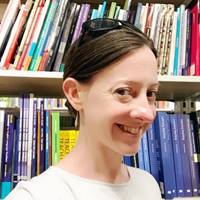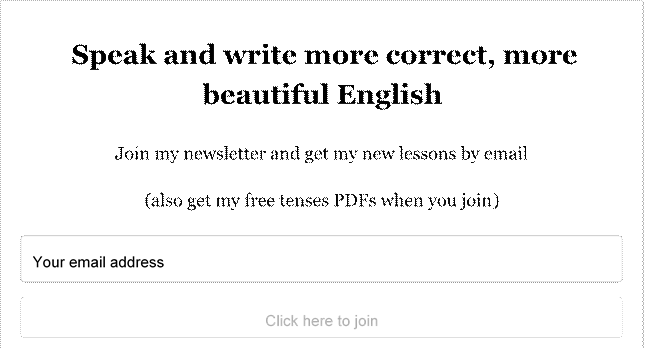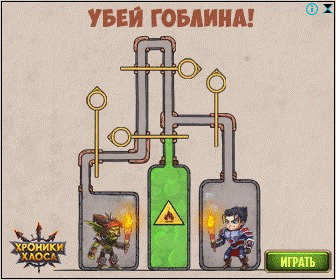
 Courses Explanations Exercises
Courses Explanations Exercises
(also called the simple present tense)
(Download this explanation in PDF)
We need to use the Present Simple a lot in English, so it's really important to understand it well. Many students have problems with the form (or how to make it).
![]() If you'd
prefer to learn about how to USE the Present Simple jump to this page.
If you'd
prefer to learn about how to USE the Present Simple jump to this page.
Or, click here for all the practice exercises about this tense.
The verb 'be' is different from the other verbs in this tense. Let's look at 'be' first:
Here's the positive form (positive means a normal sentence, not a negative or a question. This is sometimes called 'affirmative')
|
Positive |
Positive Short Form |
|
I am |
I'm |
|
you are |
you're |
|
he is |
he's |
|
she is |
she's |
|
it is |
it's |
|
we are |
we're |
|
they are |
they're |
Click here to practise making the positive with 'be'.
Next, here's the negative. It's very easy. You only add 'not'.
|
Negative |
Negative short form |
||
|
I am not |
I'm not |
||
|
you are not |
you aren't |
||
|
he is not |
he isn't |
||
|
she is not |
she isn't |
||
|
it is not |
it isn't |
|
|
|
we are not |
we aren't |
|
|
|
they are not |
they aren't |
|
|
Click here to practise making the negative with 'be'.
And finally let's talk about the question form of the present simple with 'be'.
Firstly, here's the 'yes / no' question form:
Yes / No Questions am I ? are you ? is he ? is she ? is it ? are we ? are they ?
Click here to practise making yes / no questions with 'be'.
If you'd like to make a 'wh' question, you just put the question word at the front:
|
where |
am I ? |
|
what |
are you ? |
|
why |
is he ? |
|
who |
is she ? |
|
when |
are we ? |
|
how |
are they ? |
Click here to practise making 'wh' questions with 'be' .
Click here to practise making positive, negative and question forms with 'be'
(exercise 1)
Click here to practise making positive, negative and question forms with 'be'
(exercise 2)
With all other verbs, we make the present simple in the same way.
The positive is really easy. It's just the verb with an extra 's' if the subject is 'he', 'she', or 'it'. Let's take the verb 'play' as an example:
Positive (of 'play') I play you play he plays she plays it plays we play they play
![]() Don't
forget the 's'! Even really advanced students
do this!
Don't
forget the 's'! Even really advanced students
do this!
For a few verbs, there is a spelling change before the 's'. For example, 'study' becomes 'studies'. Click here for a list of these verbs
.
![]() There
are also few verbs which are irregular in the present simple:
There
are also few verbs which are irregular in the present simple:
1. 'have' becomes 'has'
2. 'do' becomes 'does'
3. 'go' becomes 'goes'
Click here to practise making the positive form for other verbs (exercise 1) Click here to practise making the positive form for other verbs (exercise 2) To make the negative form, you need to use 'do not' (don't) or ' does not' (doesn't).
|
I do not play |
I don't play |
|
you do not play |
you don't play |
|
he does not play |
he doesn't play |
|
she does not play |
she doesn't play |
|
it does not play |
it doesn't play |
|
we do not play |
we don't play |
|
they do not play |
they don't play |
Click here to practise making the negative (exercise 1)
Click here to practise making the negative (exercise 2)
How about the question form of the present simple tense?
We use 'do' or 'does' before the subject to make the 'yes / no' question:
Yes / No questions do I play ? do you play ? does he play ? does she play ? does it play ? do we play ? do they play ?
Click here to practise making yes / no questions.
Just like with 'be', if you'd like to make a 'wh' question, you just put the question word at the front:
|
where |
do I play ? |
|
what |
do you play ? |
|
why |
does he play ? |
|
who |
does she play ? |
|
when |
do we play ? |
|
how |
do they play ? |
Click here to practise making 'wh' questions
Mixed exercise 1
Mixed exercise 2 Mixed exercise 3
Mixed exercise 4 using both 'be' and other verbs
Click here for all the exercises about this tense Next, I explain how to USE the Present Simple.
Need more practice? Get more Perfect English Grammar with our courses.

Welcome to Perfect English Grammar!

Welcome! I'm Seonaid and I hope you like the website. Please contact me if you have any questions or comments.



Материалы на данной страницы взяты из открытых источников либо размещены пользователем в соответствии с договором-офертой сайта. Вы можете сообщить о нарушении.